| 🔍 > Lean Terms Directory |
A3 Thinking
What is A3 Thinking?
A3 thinking is a philosophical approach to problem solving that centers on a well-communicated team approach to using the PDCA cycle. The tool used to apply this way of thinking is known as the A3 report.
| Download our Free A3 Report Template | |
 |

A3 Thinking Background
Whether you are a leader or a process owner, a big part of your job will entail problem solving. Taking on problems in a haphazard, random manner is a recipe for inconsistent results. A3 thinking, while not a magic solution to problems, does increase your chances of successfully solving them. The power of the A3 report lies in the structured approach it takes to solving problems.
Before diving into the A3 report, though, let’s take a look at what a problem is. Essentially, a problem is any situation when “should be” does not match reality.
That gap develops in one of two ways. Either the target gets higher, or performance drops. Regardless of how the gap came to pass, the basic problem-solving system is the same, even though the specific actions taken to close the gap may vary.
Problems with Problem Solving
There are three common failure modes that keep people from effectively solving problems.
- They treat symptoms. Treating just the surface issue leaves the root cause untouched. It will likely pop out sideways, possibly in a worse way.
- They don’t set clear goals. Without a clear end point, it is impossible to know when to stop working. Furthermore, people won’t agree on whether the project was successful or not.
- They don’t build consensus. Most significant problems cross team boundaries. Without support from affected people, problem solving fails.
PDCA (Plan-Do-Check-Act)
At the heart of most effective problem-solving methodologies is the PDCA Cycle (aka the Deming Cycle).
- Plan: Create a solid plan for solving the problem. This should include creating a deep understanding of a problem, identifying the root cause, defining the problem, and setting goals.
- Do: The plan must be implemented.
- Check: Poor problem solvers stop after the “Do” step. Good problem solvers check to see if the solution they put in place really worked.
- Act: When you identify an area where the “Do” step fell short, you must actually fix it.
The A3 Report
The A3 process is a specific, structured method of problem solving. While the A3 report is the visible centerpiece of the process, it is actually more of a result of the process than the actual process itself. The A3 report is simply a concise, communication tool. Because of the recognizable format, individuals can rapidly share ideas and have confidence in what they are talking about.
The A3 report gets its name from the “A3” size of paper used in Japan where the report originated. It is relatively close to the size of an 11×17 sheet of paper in the US.
As you continue to read about the A3 report, keep in mind that there is no set format, other than that the sections should follow the PDCA cycle. Templates (such as the ones offered at www.Velaction.com/a3-template/) are handy to use as starting points, but feel free to deviate from the precise layout if there is a good reason to do so. One warning, though, if you do make a change: make sure that sufficient space is devoted to the plan step.
A3 Communication
The A3 report is not intended as a tool for independent use. A3 reports involve several people. There should be an owner who is responsible for maintaining the document and managing the problem-solving efforts.
He or she should also have an experienced mentor who can help guide the problem solver through the A3 process. This mentor typically uses a healthy dose of the Socratic Method, pointing the person toward ways to overcome roadblocks rather than actually giving answers. The mentor, in many cases, also lends his authority to the A3 report, so the problem solver acts on the mentor’s behalf in solving the problem. This implies that the mentor needs to have some clout in the organization. Because of the mentor’s support, there is authority strapped to the A3 report. That translates to higher prioritization.
There will also be a variety of stakeholders with a vested interest in the outcome of the A3 project.
Finally, there will be the people involved in data collection, analysis, and, of course, implementing the solutions.
In most organizations, people are busy, and there is a lot coming at them. They have to separate the wheat from the chaff. One of the benefits of the A3 process is that it gets people’s attention. It is generally used for only the most significant problems in the organization, so people tend to take notice when they see the A3 report.
Another big reason that people pay attention to A3 reports is that the somewhat standard format lets them quickly get a handle on what is going on. The A3 report acts as a standardized communication tool. Readers can follow the storyboard and, without much wasted effort, know the background and status of the project.
The A3 Process
A3 thinking takes a systematic approach to problem solving. Typically, a project owner draws up the A3 report with ample support and input from all involved people. The author then runs it by the mentor throughout each step. The feedback and ideas from the discussion are then integrated into the report.
- Background
The background section is exactly what it sounds like. It is a brief section that clarifies the problem and adds context. Metrics are often shown in this box.
- Current Conditions
The current conditions section summarizes, not surprisingly, the current situation. It can show an overview of the process, highlight problems, or present anything else that will help people gain understanding of how things are now.
- Goal(s)
Specific goals should be set. In most cases, goals should have dates associated with them. An A3 report, though, is a storyboard to guide you through a process. At this point, you only know where you want to go, not how long it will take to get there. The goal dates will come out indirectly in the countermeasures step. Once the project is more fully fleshed out, though, you should add dates to the goals.
- Root-Cause Analysis
This step can take a substantial amount of time, as it is the most important one. If the root cause is not clearly identified, you’ll be solving the wrong problem. Mentors should spend significant time reviewing this step to make sure the author has it right.
- Countermeasures
Only when the root cause is understood should an A3 report author start coming up with solutions. For big projects, the countermeasures listed here might have action plans associated with them. Of particular importance is that the projected improvements from the countermeasures should add up to reach the goal.
- Effect Confirmation
It is particularly important that the effects of the countermeasures are confirmed. On occasion, positive but unexpected changes happen. If they were not predicted with the countermeasures, the root cause is likely still present. Go back and try again, or you’ll be starting the whole project over down the road.
- Follow-Up Actions
Follow-up items are not things that have to be done to get a new process up and running. They are intended to capitalize on an opportunity to add further improvement, or to help spread knowledge. In no case should the failure to do a follow-up action item prevent the full implementation of the solution.
Let me stress that point…
The success of a project should not be contingent upon follow-up actions.
If the action item list is never touched, the gains you made should be real, and they should stick. Follow-up items should be focused on going beyond the goals, or simply ‘buttoning down’ loose ends.
Benefits of A3 Thinking
- The consistency of the process supports the mentoring
- The systematic approach and recognizable format promote collaboration.
- The A3 process acts as a hands-on classroom, promoting learning and growth.
- Because of the methodical approach, solutions are more likely to have permanent fixes.
- The A3 report’s format makes it easy to spread gains around the organization.
- The act of assigning a problem-solving owner increases the likelihood of a successful project.
- The economy of language in the A3 report engages people. They know they won’t have to waste time trying to figure out what is going on.
- The collaborative process means more effective decision making.

Words of Warning With A3 Thinking
- No problem is ever truly solved. You can always go further. Some people make a point of avoiding the word “solved” altogether. You don’t need to go to that extreme but do keep in mind that improvement is an ongoing process and you will likely address the same process repeatedly over the years. You’ll identify incremental improvement opportunities, changing customer requirements will demand further improvement, or you’ll be fighting back entropy as outside forces affect your processes.
- While purists advocate handwriting an A3 report, the world is a changing place. Teams are often spread out around the whole globe, and more people than ever are working remotely. In the spirit of continuous improvement, adapt the report to suit your needs. A good technique is to handwrite the section you are working on, and then transfer it to a computer for ease of update, review, and transmission.
- Don’t expect immediate expertise in A3 reports. You’ll need a lot of practice to get good at them.
- Don’t expect immediate expertise in A3 reports. You’ll need a lot of practice to get good at them. (Note that this is intentionally mentioned twice. It is that important.)
- Don’t focus heavily on the report. The A3 thinking process is far more important.
- Use copious graphics on the report. They take far less space than words and are much clearer.
- Make sure targets are specific. Collaboration requires clarity in what people are agreeing to.
- Keep an appropriate scope. The A3 report is not an annual plan. It should be focused on a specific problem. Think “reduce dings on doors”, not “improve quality”.
- Don’t move forward without consensus. If stakeholders are not bought in…
Extended Content for this Section is available at academy.Velaction.com

In an organization that embraces A3 thinking, you will have a big role to play. While you may not be designated as the author or owner of a report, there is a great likelihood that you will see people visiting your work area, scribbling on large sheets of paper.
You will probably be asked many questions and may even be asked to collect data. If you are approached with an A3 report, ask to see it. It will give you a better understanding of how the A3 team leader sees the problem. Chances are you are closer to the process than he or she is and can probably offer some great insight. You may even identify an error that can help prevent your life from being harder down the road.
A3 Thinking and Promotions
If you aspire to move up in your organization, the A3 process is a great way to show what you can do. They tend to be used for important projects and have a good deal of attention paid to them by the decision-makers in the company. Ask your boss for some opportunities to participate in the A3 process.
Tip: Sitting in on a mentor meeting is a good way to gain knowledge about the process a little more quickly.

If you want to be a top performer in a Lean company, make A3 thinking your go-to problem solving methodology for anything that crosses a functional boundary or involves multiple work areas. In addition to helping you develop critical thinking, it hones several other skills that will be invaluable to you.
Many new leaders struggle with talking to senior managers. The A3 report gives them experience in a structured manner. They know what to expect, are working on something positive, and have a chance to be well-prepared for the meeting. It can provide a great opportunity to build a network.
That network building also extends to managers at equal levels. In some companies, leaders are so compartmentalized they seldom get to know their peers as anything more than casual acquaintances. Working together on an A3 report helps build strong relationships.
Communication skills are also refined. Put bluntly, many managers are horrible writers. Grammar aside, it can be a challenge to figure out what a person is saying. Sugar coating abounds. People are reluctant to commit to an idea…
Extended Content for this Section is available at academy.Velaction.com

Key Points About A3 Thinking
- A3 thinking is more than just filling out an A3 report. It is a way of training oneself to approach problem solving and leadership in a structured manner.
- A3 thinking is a structured thought process that is based on the PDCA cycle.
- The A3 process is not an individual activity. It requires the effort of the whole team.
![]()
Next Steps to Creating an A3 Report
- Determine if your organization has anyone with experience in mentoring others on A3 Thinking. (If you do not have anyone who can help train your organization and need help, contact us at Info@Velaction.com.)
- ID a few key people for each A3 mentor to develop.
- Train the team members on the Fundamentals of A3 Thinking.
- Identify basic projects for each individual to lead.
- Complete the projects, meeting periodically to help individuals learn from each other.
- Repeat with increasingly challenging projects.
![]()
We offer A3 templates for sale in our online store.
There are a few different sizes available. The templates are created in PowerPoint, so you can modify them to suit your needs.
Remember, though, that there is no set format for the A3 report. Our templates are just intended to be used as a starting point in your problem-solving efforts.
We also offer a free A3 Template, which you can get by clicking the image below.
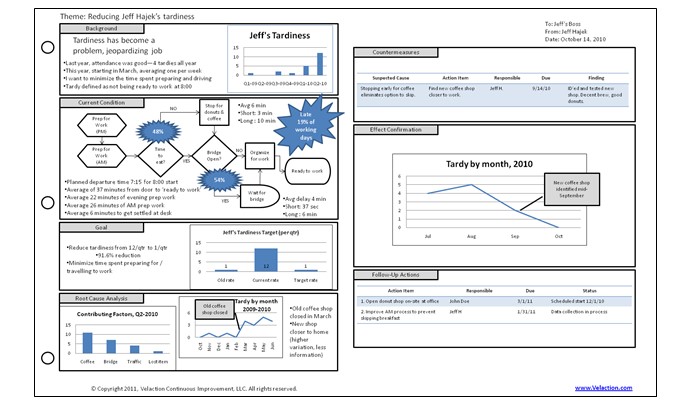
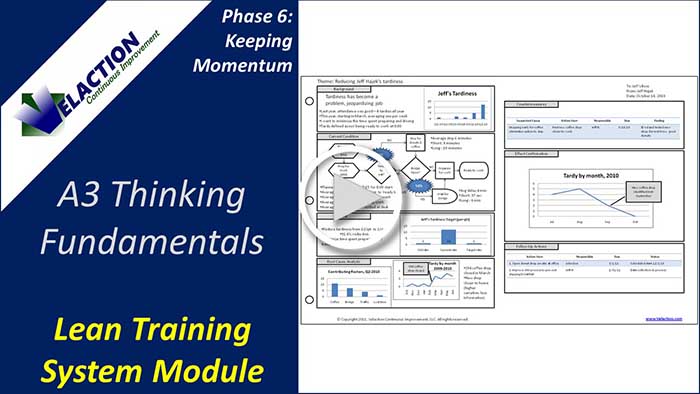
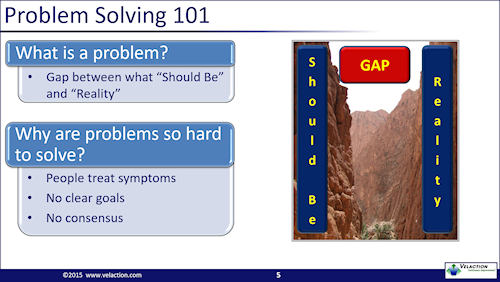
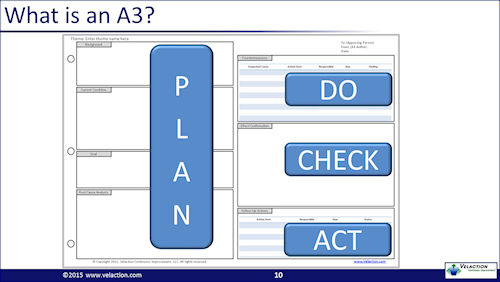
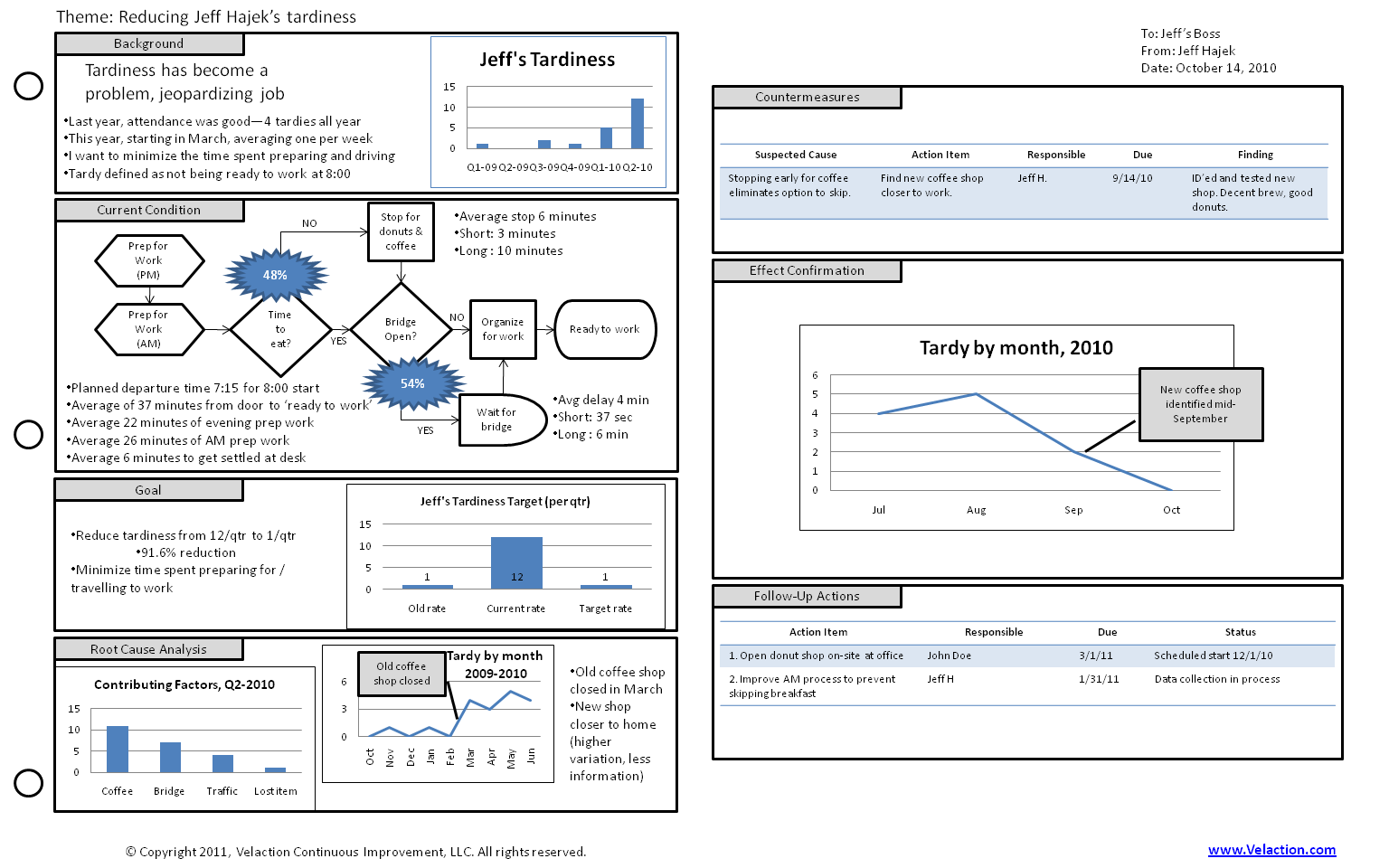
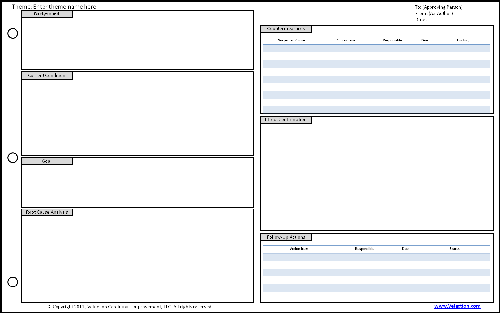
0 Comments